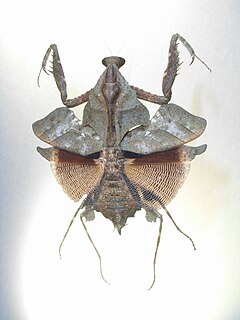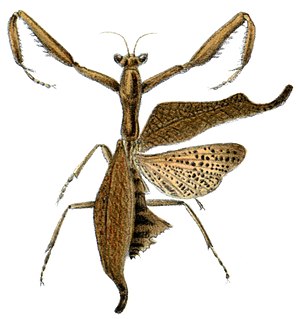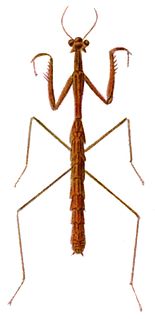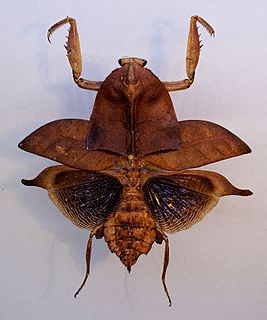
Phyllocrania paradoxa, common name ghost mantis, is a small species of mantis from Africa remarkable for its leaf-like body. It is one of the three species in the genus Phyllocrania. It is known for its distinct and exclusive camouflaged appearance of a dry weathered leaf.

Phyllocrania is a genus of mantis in the family Hymenopodidae, containing three species, Phyllocrania illudens, Phyllocrania insignis, Phyllocrania paradoxa.
Deroplatys desiccata, known by the common name giant dead leaf mantis, is a praying mantis from Southeast Asia. This is the type species of genus Deroplatys.

Deroplatys lobata, common name Southeast Asian dead leaf mantis or dead leaf mantis, is a species of praying mantis that inhabits Thailand, Java, Borneo, Indonesia, Sumatra and the Malay Peninsula.

Deroplatys is a genus of mantis in the family Deroplatyidae. They are native to Asia and several share the common name of dead leaf mantis.

Dead leaf mantis is a common name given to various species of praying mantis that mimic dead leaves. It is most often used in reference to species within genus Deroplatys because of their popularity as exotic pets. Examples include D. desiccata, D. lobata, and D. philippinica. Other species to which the term may apply include Acanthops falcataria, A. falcata, and Phyllocrania paradoxa.

Acanthops falcataria, common name South American dead leaf mantis, is a species of praying mantis in the family Acanthopidae. It is not to be confused with Acanthops falcata, a different species in the same genus that is often referred to with the same common name.

Stick mantis and twig mantis are common names applied to numerous species of mantis that mimic sticks or twigs as camouflage. Often the name serves to identify entire genera such as is the case with:
Grass mantis is a common name mostly given to various species of praying mantis that mimic grass or other slender vegetation. Species to which this name has been applied include but are not limited to:

Choeradodis rhombicollis, or Peruvian shield mantis, is a species of praying mantis native to North America, Central America, and South America. It is found in Belize, Costa Rica, Ecuador, French Guiana, Guatemala, Colombia, Mexico, Nicaragua, Panama, Peru, and Surinam.

Leaf mantis is a common name for certain praying mantises including:
Boxer mantis is a common name given to various species of praying mantis. The name comes from the way these mantises move their oversized grasping forelimbs as they communicate with each other.

Bark mantis is a common name given to various species of praying mantis, especially those with cryptic camouflage resembling tree bark. Examples include:
Ground mantis is a common name given to various species of praying mantis believed to hunt on or near ground level rather than high amid foliage.

Acanthops is a genus of mantises in the family Acanthopidae, containing 20 species that can be found in Central and South America.
Acanthops royi is a species of praying mantis in the family Acanthopidae and is one of many mantis from various genera that resembles a dead leaf.
Acanthops centralis is a species of praying mantis in the family Acanthopidae and is one of many mantis from various genera that resembles a dead leaf.

Deroplatys truncata is a species of praying mantis in the family Deroplatyidae.
Acanthops falcata, common name South American dead leaf mantis or boxer mantis, is a species of praying mantis in the subfamily Acanthopinae of the family Acanthopidae and is one of many praying mantises from various genera that resembles a dead leaf.










